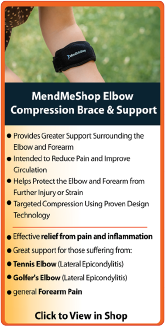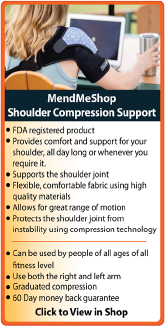More Facts About Achilles Tendonitis:
The Achilles tendon does not have a rich blood supply. Blood supply is weakest at a point between 2 and 6 cm above its insertion into the calcaneus (heel bone).
Ignoring pain in the Achilles tendon (ie. "running through the pain") is the biggest cause of chronic Achilles tendonitis.
For cyclists, initial Achilles tendon stress is often caused by having a low saddle height. This low saddle height can result in excessive dorsiflexion of the foot, which stresses the Achilles tendon.
The Achilles tendon is the connection between the heel and the most powerful muscle group in the body.
Tennis and soccer players over 40 are the most frequent sufferers of tennis leg (calf muscle strain).
Sudden increases in running and or active sprinting sports can cause Achilles tendonitis.
Excessive running up and down hills can aggravate the Achilles tendon.
Stiff shoe soles at the ball of the foot will increase Achilles tendon strain.
Excessive heel shock absorption can overstretch the Achilles tendon.
Tight hamstrings and/or tight calf muscles create excess strain on the Achilles tendon.
For triatheletes, the most common cause of injuries to the Achilles tendon is overpronation, inflexibility, or lack of strength.
Immobility, due to an Achilles injury, may result in a contracted Achilles tendon and an increased amount of scar tissue.
|
Sprains and Strains:
What's the Difference?
What is a Sprain?
A sprain is a stretch and/or tear of a ligament (fibrous band of connective tissue that joins bone to bone). Every joint in the body is stabilized and supported by a ligament. They help control range of motion and enabling us to complete simple tasks such as walk and run.
What is a Strain?
A strain is an injury of a muscle and/or tendon. Tendons (fibrous cords of tissue that attach muscles to bone).
Sprains and strains are among the most common injuries in sports, professional, amateur athletes and the general public. You are more at risk for the injury if you have a history of sprains and strains, are overweight, and are in poor physical condition.
Sprains and strains are categorizes according to severity:
- MILD - A ligament or muscle is stretched in a mild sprain, but there is no joint loosening.
- MODERATE - A moderate sprain partially tears the ligament or muscle, producing joint instability, and some swelling.
- SEVERE - A severe sprain produces excruciating pain at the moment of injury, as ligaments or muscle tear completely, or separate from the bone. A complete rupture makes the joint nonfunctional and will generally require some form of surgery.
You should seek medical attention if you can't walk more than four steps without pain, can't move the affected joint and you have numbness in any part of the injured area.
SPRAIN
What are the signs of a sprain?
While the intensity varies, pain, bruising, swelling, limited ability to move the affected joint, and inflammation are common to all three categories of sprains: mild, moderate, and severe. You may feel a tearing or hear a 'pop' sound in the joint.
What causes sprains?
A sprain is caused by direct or indirect trauma (a fall, a blow to the body, etc.) that knocks a joint out of position, and overstretches, and, in severe cases, ruptures the supporting ligaments. This injury occurs when an a person lands on an outstretched arm; slides into a base; jumps up and lands on the side of the foot; or runs on an uneven surface.
Common Sprains
- Ankle sprain. The foot twists, rolls or turns beyond its normal motions. You can sprain your ankle if the foot is planted unevenly on a surface, beyond the normal force of stepping. Approximately 25,000 people each day suffer the pain of an ankle sprain. (source American Academy of Orthopaedic Surgeon) The foot and ankle is made up primary of ligaments holding the bones together. There are 7 ankle related sprains; high ankle, lateral, inversion, eversion, syndesmosis, anterior talofibular ligament, and anterior inferior tibiofibular ligament sprains! Sports related to high risk ankle sprains, are one that require sudden changes in direction, like football, soccer, and basketball and basketball.
 - Knee sprain. There are 4 major ligaments in the knee:
- Anterior cruciate ligament (ACL) and posterior cruciate ligament (PCL) bridge the inside of the knee joint, forming an "X" pattern that stabilizes the knee against front-to-back and back-to-front forces. A sudden stop; a twist, pivot or change in direction at the joint; extreme overstraightening (hyperextension); or a direct impact to the outside of the knee or lower leg. Knee sprain injuries are seen among athletes in football, basketball, soccer, rugby, wrestling, gymnastics and skiing.
- Medial collateral ligament (MCL) supports the knee along the inner side of the leg. Like the ACL, the MCL can be torn by a direct sideways blow to the outside of the knee or lower leg, the kind of blow that can happen in football, soccer, hockey and rugby. The MCL can be injured by a severe knee twist during skiing or wrestling, particularly when a fall twists the lower leg outwards, away from the upper leg.
- Lateral collateral ligament (LCL) supports the outer side of the knee. It is the least likely knee ligament to be sprained because most LCL injuries are caused by a blow to the inside of the knee, and that area usually is shielded by the opposite leg.
More than any other group, competitive athletes have a very high risk of knee sprains and other types of knee problems.
- Wrist sprain. A fall onto an outstretched hand, the force impact bends the wrist back toward your forearm, stretching and ligaments that connect the wrist and hand bones a little to far. A momentary loss happens during everyday activities, but frequently occurs during sports and outdoor recreation. Wrist sprains are common with basketball, baseball, gymnasts, divers, skiers (especially when they fall while still holding a pole), skaters, skateboarders, and inline skaters
- Finger sprain. Injury to three joints of the fingers 'jamming' the finger into an opponent or being hit on the tip of the finger by a ball. Bending the finger backward (hyperextended). Are often overlooked as 'just a finger', finger injuries can be very painful and lead to chronic ailments (trigger finger) if not treated correctly.
- Toe sprain. Stubbing your toe into something, stopping suddenly when running or landing awkwardly from a jump 'jamming' your toe into your shoe. Sports such as football, soccer, rugby, basketball and running.
STRAIN
What are the signs of a strain?
Signs include pain, muscle spasm, muscle weakness, swelling, inflammation, limited ability to move the affected muscle, and cramping. With a mild strain, the muscle/tendon is stretched or pulled, slightly. Some muscle function will be lost with a moderate strain, where the muscle/tendon is overstretched and slightly torn. In severe strains, the muscle and/or tendon is partially or completely ruptured, often disabling the person.
Common Strains
- Achilles tendon strain. Pain along the back of your foot and above your heel, especially when stretching your ankle or standing on your toes. Most strains are mild. The seriousness of the strain will affect your walking. Suddenly increase your activity or warm up improperly can cause an Achilles tendon strain. Trying to go fast, jumping (hurdles), cutting (football) or twisting in the air are just some of the scenarios where you could develop Achilles tendon strain. Read more about Achilles tendon strain here.
- Back strain. When the muscles that support the spine are twisted, pulled, or torn, the result is a back strain. Athletes who engage in a lot jumping (during basketball, volleyball, etc.) are at risk to this injury. Everyday activities can lead to back strain, pickup a heavy item and twisting at the same time as in loading groceries into the car, carrying laundry up stair and turning too quickly.
- Hamstring muscle strain. A hamstring muscle strain is a tear or stretch of a major muscle in the back of the thigh. The injury can sideline a person for up to six months. The likely cause is muscle strength imbalance between the hamstrings and the muscles in the front of the thigh, the quadriceps. Kicking a football, running, or leaping to make a basket can pull a hamstring. Hamstring injuries tend to recur. Read more about the Hamstring strain here (aidyourhamstring.com)
- Quadricep strain. Muscle strain in the front thigh (quadriceps muscles in the front, and the adductor muscles on the inside.). The hamstring and quadriceps muscle groups are particularly at risk for muscle strains because they cross both the hip and knee joints. They are also used for high-speed activities, such as track and field events (running, hurdles, long jump), football, basketball, and soccer.
- Calf strain. Stretches, tears, or incomplete ruptures of the large calf muscles (gastrocnemius). Also called 'Tennis leg' happens when lunging or pushing off one leg to get to a wide ball or serve. May also happen with daily activities, such as running to catch a bus or climbing stairs. It feels like being kicked in the leg from behind. The tennis leg sufferer feels an quick severe sharp pain, turns around to see who kicked them, only to discover that no one is there. Go here to read more information about Tennis leg
- Elbow strain. A strain is when a muscle becomes overstretched and tears. This painful injury, also called a "pulled muscle," can be caused by an accident, improper use of a muscle, or overuse of a muscle. Frequently occur in racquet, throwing, and contact sports.
- Shoulder strain. Your shoulders are the most movable joints in your body. Overuse, repetitive motion or an unnatural twisting of the shoulder are causes of shoulder strain. Quite often the due to swelling, which can make almost any movement in the cavity of the shoulder joint both difficult and uncomfortable.
- Hand strain. Repetitive strain injuries are linked with work related usage of the hands. A tight grip or squeezing the hand overstretches the hand muscles. Women are at high risk as 'standard' hand tools are often too large, too wide or too slippery. Sports such as gymnastics, tennis, rowing, golf-sports that require extensive gripping-have a high rate of injury.
- Neck strain. Not considered a serious injury, but there is pain and dysfunction of the neck. The causes are too much time in an awkward position (hunched over a steering wheel while driving, hunched forward to view a computer monitor, or cradling a phone in the crook of the neck). Sleeping in a position that strains the neck, such as with a pillow that is too high or too firm. Carrying a heavy suitcase or other object on one side of the body.
Conservative Treatment Options for Strains and Sprains
In cases of mild and moderate sprains and strains, your physician will usually recommend conservative treatment options (click to view). In severe cases, surgery may be undertaken after which you will enter a period of surgical recovery. click here to view more information about surgical recovery.
Learn More About Achilles Injuries & TreatmentsI want to learn more about Achilles Surgery & Post-Surgery Recovery I want to learn more about Circulation Boost I want to learn more about Ice & Heat: Which Is Better For The Achilles? I want to learn more about Stretching for the Achilles
FREE SHIPPING ON ALL PRODUCTS CURRENTLY ENABLED
60 DAY TRIAL PERIOD
During your recovery, you will probably have to modify and/or eliminate any activities that cause pain or discomfort at the location of your soft tissue injury until the pain and inflammation settle. The more diligent you are with your treatment and rehabilitation, the faster you will see successful results!
|

Achilles Tendon Facts
There are over 250,000 achilles tendon injuries each year in the US.
Achilles tendon ruptures are common in people between the ages of 30 and 50.
In runners, too rapid an increase in mileage, hill training without proper strengthening, and recent or inadequate changes to running gear can cause injuries to the Achilles tendon.
Achilles tendonitis accounts for an estimated 11% of running injuries.
3-5% of athletes are forced to leave their sports career due to Achilles tendon overuse injuries that go untreated.
Medications mask the pain but do very little in the healing of Achilles tendonitis.
A fully ruptured tendon REQUIRES surgery. It will not heal on its own.
Achilles tendonitis and Achilles tendinitis are the same thing.
Continually using your Achilles tendon while it is injured will lead to a more serious and/or chronic injury.

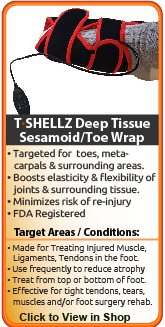


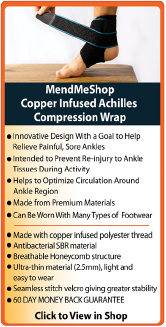
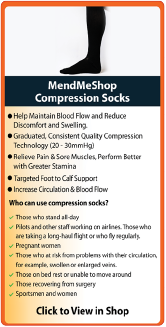
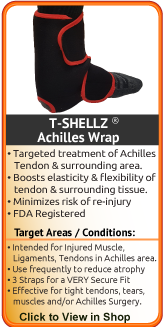


|










